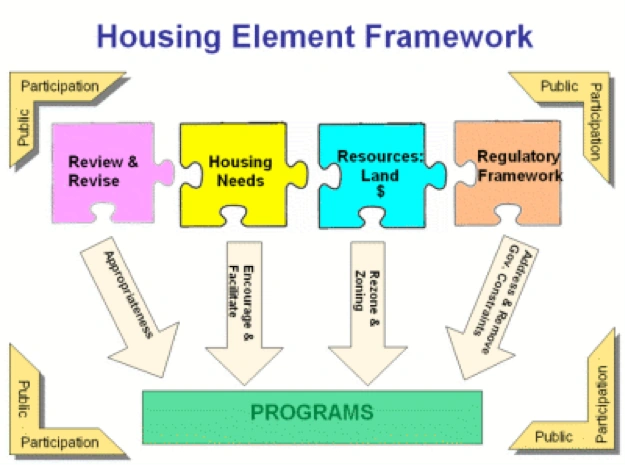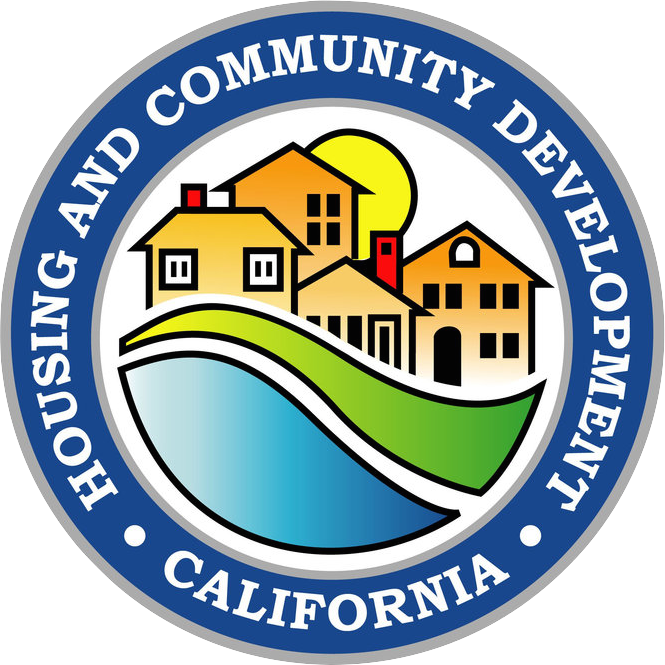Before You Start
Since 1969, California has required that all local governments (cities and counties) adequately plan to meet the housing needs of everyone in the community. California’s local governments meet this requirement by adopting housing plans as part of their “general plan” (also required by the state).
General plans serve as the local government’s "blueprint" for how the city and/or county will grow and develop and include seven elements: land use, transportation, conservation, noise, open space, safety, and housing. The law mandating that housing be included as an element of each jurisdiction’s general plan is known as “housing-element law.”
California’s housing-element law acknowledges that, in order for the private market to adequately address the housing needs and demand of Californians, local governments must adopt plans and regulatory systems that provide opportunities for (and do not unduly constrain), housing development. As a result, housing policy in California rests largely on the effective implementation of local general plans and, in particular, local housing elements.

The supply of housing is critical to achieving a variety of community objectives, including economic development, greenhouse gas reduction (by building homes near transit), improved health (through safer, less-dangerous housing and increased family stability), and community building.
An effective housing element provides the necessary conditions for preserving and producing an adequate supply of housing affordable to people at a variety of income levels. Among other things, the housing element provides an inventory of land adequately zoned or planned to be zoned for housing, certainty in permit processing procedures, and a commitment to assist in housing development through regulatory concessions and incentives. In addition to this fundamental framework, the housing-element update process provides a vehicle for establishing and updating housing and land-use strategies to reflect changing needs, resources, and conditions. For example, the housing-element update process can serve as the vehicle for a jurisdiction to adopt new strategies that promote infill or mixed-use development or downtown revitalization.
The housing element also provides a powerful tool to address the special housing needs of farmworkers, people with disabilities, and people who are experiencing homelessness. The housing-element process ensures local governments promote a variety of housing types, including multifamily rental housing, manufactured housing, and transitional and other types of supportive housing. For example, California’s Mental Health Services Act (Proposition 63) provides financial resources to build supportive housing and addresses homelessness for people who have mental-health issues.
The housing-element update process also creates opportunities to increase interest in smart-growth planning. The housing element provides practical policy tools to promote efficient land-use patterns while meeting critical housing needs. The housing element process provides a vehicle for coordinating infrastructure, housing finance, and long-term land-use planning. For example, the housing element is often a coordinating document, providing a schedule for local housing departments to apply for important housing and community development funds. The update process also provides a mechanism to review ordinances; identify outdated policies; or modify codes that inhibit housing supply, affordability, and choice. Many local governments have established new permit procedures to streamline the approval process for infill or higher-density housing during the update of the housing element.
Not only does the housing element update process result in strategies to address local housing needs, it is also frequently the most-effective tool to implement broader general plan and regional strategies, including “California regional blueprints” or “sustainable community strategies” (SCS). Local governments can promote land-use patterns consistent with the region’s SCS while meeting critical housing needs. Without adequate planning of affordable housing near jobs, development patterns may result in increased vehicle miles traveled and negatively impact greenhouse gas reduction goals outlined in the region’s SCS.
Assessment: Calculating the Housing Need in Each Region
In order to create a housing element that shows a jurisdiction could meet the local housing need, the jurisdiction must first know how much housing it must plan for (and estimate how much will be needed at a variety of affordability levels in order to match the needs of the people who will live there). This is determined by a process called the regional housing needs assessment.
HCD is responsible for determining the regional housing needs assessment (segmented by income levels) for each region’s planning body known as a “council of governments” (COG). HCD starts with demographic population information from the California Department of Finance and uses a formula to calculate a figure for each region/COG.
Each COG uses its own demographic figures to calculate what it believes the regional housing needs are.
Each COG then coordinates with the California Department of Housing and Community Development (HCD) — taking into account factors not captured in the calculations — to arrive at a final figure. This final figure is the regional housing needs assessment.
Allocation: Divvying up the Need Amongst Cities and Counties
Once HCD and the COG have agreed to the region’s assessment figure (the amount of housing that must be planned for), the COG takes over and is responsible for divvying up (allocating) the housing need amongst all of the jurisdictions (cities/counties) within that region. The COG does this in a Regional Housing Need Allocation Plan (RHNA Plan).
The RHNA Plan is required to promote the following objectives:
- Increase the housing supply and the mix of housing types, tenure (rental or ownership), and affordability in all cities and counties within the region in an equitable manner.
- Promote infill development and socioeconomic equity, the protection of environmental and agricultural resources, and the encouragement of efficient development patterns.
- Promote an improved intraregional relationship between jobs and housing.
Housing-element law requires local governments to be accountable for ensuring that projected housing needs reflected by the RHNA Plan can be accommodated. The process maintains local control over where and what type of development should occur in local communities, while providing the opportunity for the private sector to meet market demand. Housing-element law recognizes the most critical decisions regarding housing development occur at the local level, within the context of the periodically updated general plan. The RHNA Plan component of the general plan requires local governments to balance the need for growth, including the need for new housing, against other competing local interests. The process of creating the RHNA Plan promotes the state's interest in encouraging open markets and providing opportunities for the private sector to address the state's housing demand, while leaving the ultimate decision about how and where to plan for growth at the regional and local levels. While land-use planning is fundamentally a local issue, the availability of housing is a matter of statewide importance.
The housing element process includes the following steps:
- Update previous housing element.
- Public Participation Requirements: Prior to submittal of the first draft within a planning period to HCD, the local government must make the draft available for public comment for 30 days and if any comments were received, take at least 10 business days to consider and incorporate public comments.
- Submit draft to HCD for review/approval.
- Revise and adopt (or adopt without changes).
- Transparency Requirements: For any subsequent draft revision, the local government must post the draft revision on its website and email a link to all individuals and organizations that have previously requested notices relating to the local government’s housing element at least seven days before submitting the draft revision to HCD.
- Submit revised draft/adopted housing element to HCD.
Update Previous Housing Element
The rest of the Building Blocks pages will assist you in updating your previous housing element.
Submit Draft to HCD for Review/Approval
Once a jurisdiction has updated its housing element, it submits the draft to HCD. HCD has 90 days to review the first draft submittal within a planning period and 60 days to review the draft and report its findings back to the jurisdiction.
Revise and Adopt (or Adopt without Changes)
Once the jurisdiction receives the findings from HCD, it can then revise the housing element to comply with the statute and adopt it OR adopt the draft without revising it. If it adopts the draft without making any revisions, it must specify in the resolution the findings that explain why the housing element complies with the statute.
Submit Adopted Housing Element to HCD
After the adoption, the jurisdiction must promptly submit its adopted housing element to HCD for review. HCD has 60 days to review the adopted housing element and report its findings back to the jurisdiction.
In the preparation of its findings, HCD may consult with any public agency, group, or person and must consider any third-party comments regarding the draft or adopted element or amendment under review.
How To Submit the Housing Element to HCD
To submit the housing element to HCD, local government have two options:
- Hard Copy Submittal — Please send one hard copy of the housing element to HCD with a cover letter indicating if the element is a draft or adopted element. Please also include an electronic version (USB Flash drive) with the submittal.
- Email Submittal — Send the housing element to HousingElements@hcd.ca.gov with a cover letter indicating if the element is a draft or adopted element. Please mail a subsequent hard copy for the files. Please note, some elements will be too large to be received through the email system. Please ensure your element was received by the system. HCD has limited capacity to receive elements through google docs or other similar download links. Elements that are too large will be required to be mailed.
The housing element will be logged for review on the business date received. Housing elements received after business hours will be logged for review on the next business day.
All hard copies of the housing element can be sent to:
State Department of Housing and Community Development
C/O Land Use and Planning Unit
651 Bannon Street, Suite 400
Sacramento, CA 95811
Housing Element Submittal Requirements:
For first draft submittals: With the first draft submittal, please include in the cover letter how the local government complies with new public participation requirements pursuant to AB 215 (Chapter 342, Statutes of 2021). AB 215 requires that prior to submittal of the first draft to the California Department of Housing and Community Development (HCD), the local government must make the draft available for public comment for 30 days and if any comments were received, take at least 10 business days to consider and incorporate public comments. Please note, HCD cannot review any first draft submittals that have not demonstrated completion with this requirement. The housing element will be considered submitted to HCD on the date that documentation has been received verifying compliance with AB 215 public participation requirements.
For revised submittals: To facilitate the review of revisions to address HCD findings, HCD requests submittal of a version of the housing element that clearly shows the changes between the previous housing element submittal and the new revised version. In addition, in the element or in a cover letter, please indicate compliance with AB 215 requirements to post the draft revision on the local government’s website and to email a link to all individuals and organizations that have previously requested notices relating to the local government’s housing element at least seven days before submitting the draft revision to HCD.
For adopted housing elements: With the adopted element submittal, please attach a copy of the resolution adopting the housing element. In addition, pursuant to SB 6 (Chapter 667, Statutes of 2019), for a housing element or amendment adopted on or after January 1, 2021, the planning agency shall submit to HCD an electronic copy of its inventory of these parcels using standards, forms, and definitions adopted by HCD (see below). Electronic sites inventories should be submitted to sitesinventory@hcd.ca.gov with the submittal of the adopted element.

The following framework illustrates how the housing-element requirements interrelate. Results from each of the four key components of the analysis — review and revise, housing needs, resources, and constraints — are reflected in the policies, programs, and objectives found within the implementation plan. The entire process must reflect by public participation from draft stage to final adoption.
View larger image of Housing Element Framework.
To strengthen the connection between housing and transportation planning, SB 375 made changes to better align the schedules for housing-element updates with schedules for adopting regional transportation plans (RTPs). Update schedules are found on our Regional Housing Needs and Housing Elements main page under the heading "Housing Elements."

